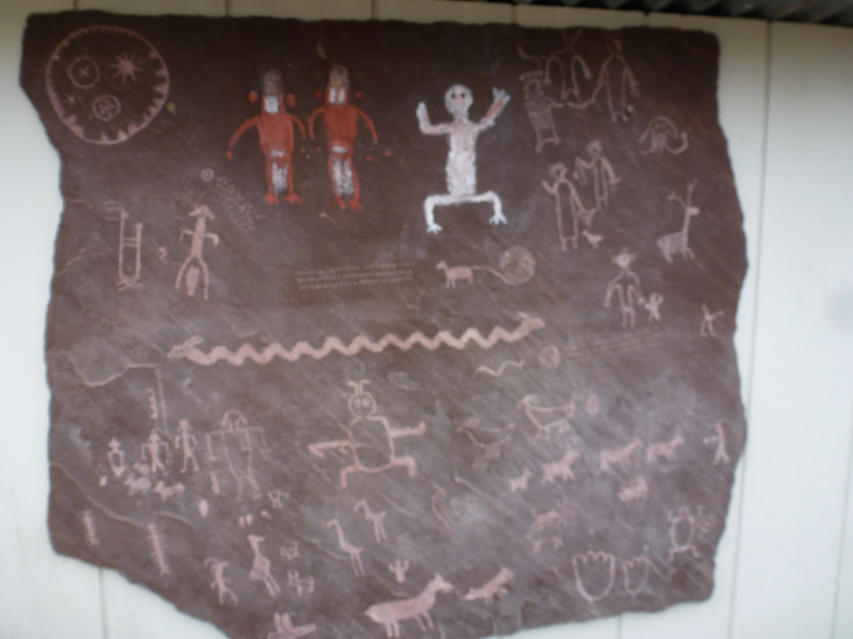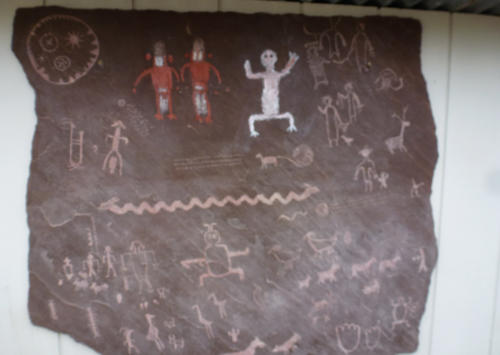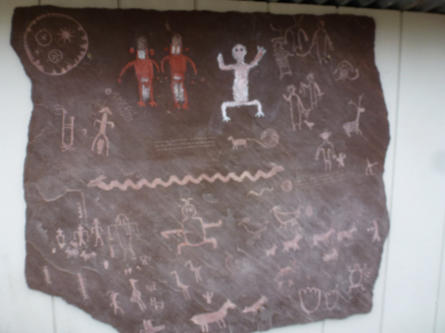


© 2014-2021 Copyright by P. K. H. Groth, Denver, Colorado, USA All rights reserved - See contact page for for permission to republish article
excerpts.
Scouting Using Archeology
Native Americans had to be efficient and successful hunters to survive. This demanded they critically
observe their surroundings and contrive tactics to gain the protein source of wild game. These people
rarely spoiled their environment with billboards, directional signs, or non-important art. You can be a
better hunter if you train yourself notice the tell-tale remnants of their hunting practices and
locations.
I recreated this Native American hunting scenes panel from SW US pictograph photos. They illustrate
the actual, imagined, or wished for outcomes of hunting and observing nature. Their presence where
they were left indicate the kind of game available there at that time. The pictographs also illustrate
the influences of white explorers and clergy during early historic times. Do some thinking about what
the narrative are trying to record.
SW Region Colorado Parks Manager Pat Dorsey (2016) points out that many of the camping sites used
today were probably also used by early Americans. The chosen locations offered water, elevation for
game observation, and access to migration game trails. Linda and I are fortunate to be able to
antelope hunt on a large Wyoming ranch for twenty-five years. Linda has certifications in archaeology,
and we both have geology degrees. It is easy to see topographic aberrations, human built crude
structures and artifacts (all left as we found them). Conjuring the mindset of ancient hunters is a
pleasant and added hunt past time. I give us an idea how Native Americans and early
explorers/settlers hunted, and where they consistently found game.
Here are examples of observations.
1. A star-scared Impact stone at ranch ambush site at the top of a ravine, where an open grass
grazing area is adjacent to vegetation barren badlands terrain. This stone was probably used to crack
open large bones to extract the rich marrow. There is opportunity at this location to hide from
Wyoming’s constant high winds in lside trenches of a major ravine through which the antelope and
elk would travel to get to grass and sage pasture. A large rock is tilted vertical as a one-man hunting
blind. A stone ax lies where meat-processing Americans may have inadvertently left it.
2. Ambush site – rocks piled along game trail, in a talus slope where game cannot veer off the trail.
Cattle will not walk over an actual or perceived (painted graating) cattle guard. Game is reluctant to
walk over scree that moves underfoot.
3. Indian Camp – escape route for elk and deer to get away from winds and bad weather. Elk and
deer do not like high wind conditions. It prevents using hearing as a safety indicator.
4. Arrowhead hill on ranch – there are wood plank remnants of an early settler or miner’s spring box
along hillside, where water once trickled out. Game trails radiate from it. Once established, game
trails on hillsides tend to be use by game, even though the original attraction (spring) has vanished.
Perhaps the ephemeral spring was also a salty attraction to game.
5. Elk extensively used a particular spring, while other springs and seeps were not used. Evidently,
that spring had good, not salty, non-sulfurous water that the elk favored.
6. Teepee rings indicate Native American longer-term camps. They would not have stopped there so
long if historically there were not abundant plant foods and game.
7. We have a restored settler cabin that was located adjacent to a spring. This location was
prehistorically and historically was used for camping by Native Americans. The evidence is the
succession of arrowheads found, from ancient simple quartzite points to heads made from brown
beer bottle glass.
8. The Wyoming winds can be tough on the sandy soil landscape. I once located a deep blowout hole,
which must have been created where local topography concentrated a vortex of wind energy. I know
the blowout hole was used as a hiding place to ambush game in the tree-less open area. A previous
native hunter had lost his prized possession. The large black obsidian spearhead had lain in the white
sand blowout hole for perhaps a thousand years. (This perfect spear point must have be highly treasured. I
have to wonder if the ancient hunter sought refuge in the blowout hole from a cruel typical high-wind snow
storm, where he froze to death. He and his spear shaft melted into oblivion, leaving the point as the only history of
his being.)





- Hunter welfare
- Hunter poster child
- Altitude sickness
- Hunter heart attacks
- Hunter heart stress
- Altitude sleep problems
- Hunter spine/bone damage
- Back country hazards
- Man made hazards
- Hunter bear attacks
- Bear problems
- Mtn lion Awareness
- Insect problems and diseases
- Hunt camp rodent problems
- Game meat dangers
- Elk meat diseases



© 2016 -2021 Copyright by P. K. H. Groth, Denver, Colorado, USA All rights reserved -
See contact page for for permission to republish article excerpts.
Native Americans had to be efficient and
successful hunters to survive. This demanded
they critically observe their surroundings and
contrive tactics to gain the protein source of wild
game. These people rarely spoiled their
environment with billboards, directional signs, or
non-important art. You can be a better hunter if
you train yourself notice the tell-tale remnants
of their hunting practices and locations.
I recreated this Native American hunting scenes
panel from SW US pictograph photos. They
illustrate the actual, imagined, or wished for
outcomes of hunting and observing nature.
Their presence where they were left indicate the
kind of game available there at that time. The
pictographs also illustrate the influences of
white explorers and clergy during early historic
times. Do some thinking about what the
narrative are trying to record.
SW Region Colorado Parks Manager Pat Dorsey
(2016) points out that many of the camping sites
used today were probably also used by early
Americans. The chosen locations offered water,
elevation for game observation, and access to
migration game trails. Linda and I are fortunate
to be able to antelope hunt on a large Wyoming
ranch for twenty-five years. Linda has
certifications in archaeology, and we both have
geology degrees. It is easy to see topographic
aberrations, human built crude structures and
artifacts (all left as we found them). Conjuring
the mindset of ancient hunters is a pleasant and
added hunt past time. I give us an idea how
Native Americans and early explorers/settlers
hunted, and where they consistently found
game.
Here are examples of observations.
1. A star-scared Impact stone at ranch ambush
site at the top of a ravine, where an open grass
grazing area is adjacent to vegetation barren
badlands terrain. This stone was probably used
to crack open large bones to extract the rich
marrow. There is opportunity at this location to
hide from Wyoming’s constant high winds in
lside trenches of a major ravine through which
the antelope and elk would travel to get to grass
and sage pasture. A large rock is tilted vertical as
a one-man hunting blind. A stone ax lies where
meat-processing Americans may have
inadvertently left it.
2. Ambush site – rocks piled along game trail, in
a talus slope where game cannot veer off the
trail. Cattle will not walk over an actual or
perceived (painted graating) cattle guard. Game
is reluctant to walk over scree that moves
underfoot.
3. Indian Camp – escape route for elk and deer
to get away from winds and bad weather. Elk
and deer do not like high wind conditions. It
prevents using hearing as a safety indicator.
4. Arrowhead hill on ranch – there are wood
plank remnants of an early settler or miner’s
spring box along hillside, where water once
trickled out. Game trails radiate from it. Once
established, game trails on hillsides tend to be
use by game, even though the original attraction
(spring) has vanished. Perhaps the ephemeral
spring was also a salty attraction to game.
Scouting With Archaeology




- Hunter welfare
- Hunter poster child
- Altitude sicknesses
- Hunter heart attack
- Hunter heart stress
- Altitude sleep problems
- Hunter spine and bone injuries
- Back country hazards
- Man caused hazards
- Bear attacks
- Bear camp problems
- Mountain. lion awareness
- Insect diseases and problems
- Camp rodent problems
- Game meat dangers
- Elk diseases

























